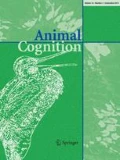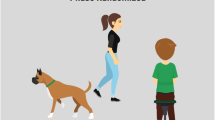Abstract
Affiliation between interacting partners is associated with a high level of behavioural synchronization in many species. Pet dogs are known to share strong affiliative bonds with their owners and to synchronize their behaviour with them when moving freely indoors. Surprisingly, outdoor dog–human interspecific synchronization has seldom been investigated. We therefore explored whether, when allowed to move freely in a familiar outdoor space, dogs synchronize their behaviour with their owners’ movements. We found that dogs visibly synchronized both their location (staying in close proximity) and their activity (moving when their owner moved, and at the same pace, and standing still when their owner stood still) with those of their owners. By demonstrating that owners act as attractors for their dogs in an outdoor space, the present study contributes new data to the understanding of interspecific behavioural synchronization.


Similar content being viewed by others
References
Ákos Z, Beck R, Nagy M, Vicsek T, Kubinyi E (2014) Leadership and path characteristics during walks are linked to dominance order and individual traits in dogs. PLoS Comput Biol 10(1):e1003446
Bonanni R, Cafazzo S, Valsecchi P, Natoli E (2010) Effect of affiliative and agonistic relationships on leadership behaviour in free-ranging dogs. Anim Behav 79:981–991
Charan J, Biswas T (2013) How to calculate sample size for different study designs in medical research? Indian J Psychol Med 35:121–126
Chartrand TL, Bargh JA (1999) The chameleon effect: the perception–behavior link and social interaction. J Pers Soc Psychol 76(6):893–910
Chartrand TL, Lakin JL (2013) The antecedents and consequences of human behavioral mimicry. Ann Rev Psychol 64:285–308
Chartrand TL, van Baaren R (2009) Human mimicry. Adv Exp Soc Psychol 41:219–274
Condon WS, Sander LW (1974) Neonate movement is synchronized with adult speech: interactional participation and language acquisition. Science 183(4120):99–101
D’Aniello B, Scandurra A (2016) Ontogenetic effects on gazing behavior: a case study of kennel dogs (Labrador retrievers) in the impossible task paradigm. Anim Cogn 19:565–570
D’Aniello B, Scandurra A, Prato-Previde E, Valsecchi P (2015) Gazing toward humans: a study on water rescue dogs using the impossible task paradigm. Behav Process 110:68–73
D’Aniello B, Scandurra A, Alterisio A, Valsecchi P, Prato-Previde E (2016) The importance of gestural communication: a study of human-dog communication using incongruent information. Anim Cogn 19:1231–1235
Dávid-Barrett T, Dunbar RIM (2012) Cooperation, behavioural synchrony and status in social networks. J Theor Biol 308:88–95
Duranton C, Gaunet F (2015) Canis sensitivus: affiliation and dogs’ sensitivity to others’ behavior as the basis for synchronization with humans? J Vet Behav Clin Appl Res 10:513–524
Duranton C, Gaunet F (2016) Behavioural synchronization from an ethological perspective: short overview of its adaptive values. Adapt Behav 24(3):181–191
Duranton C, Rödel HG, Bedossa T, Belkhir S (2015) Inverse sex effects on performance of domestic dogs (Canis familiaris) in a repeated problem solving task. J Comput Psychol 129:84–87
Duranton C, Bedossa T, Gaunet F (2016) When facing an unfamiliar person, pet dogs present social referencing based on their owner’s direction of movement alone. Anim Behav 113:147–156
Duranton C, Bedossa T, Gaunet F (2017a) Do shelter dogs engage in social referencing with their caregiver in an approach paradigm? An exploratory study. Appl Anim Behav Sci 189:57–65
Duranton C, Bedossa T, Gaunet F (2017b) Interspecific behavioural synchronization: dogs present locomotor synchrony with humans. Sci Rep 7:12384
Fallani G, Prato Previde E, Valsecchi P (2007) Behavioral and physiological responses of guide dogs to a situation of emotional distress. Physiol Behav 90:648–655
Ferrari PF, Paukner A, Ionica C, Suomi SJ (2009) Reciprocal face-to-face communication between rhesus macaque mothers and their newborn infants. Curr Biol 19(20):1768–1772
Gácsi M, Gyori B, Miklósi Á, Virányi Z, Kubinyi E, Topál J, Csányi V (2005) Species-specific differences and similarities in the behavior of hand-raised dog and wolf pups in social situations with humans. Dev Psychol 47(2):111–122
Gaunet F, Pari-Perrin E, Bernardin G (2014) Description of dogs and owners in outdoor built-up areas and their more-than-human issues. Environ Manag 54(3):383–401
Guéguen N, Jacob C, Martin A (2009) Mimicry in social interaction: its effect on human judgment and behavior. Eur J Soc Sci 8(2):253–259
Kendon A (1970) Movement coordination in social interaction: some examples described. Acta Psychol 32:100–125
Kubinyi E, Miklósi Á, Topál J, Csányi V (2003) Social mimetic behaviour and social anticipation in dogs: preliminary results. Anim Cogn 6:57–63
Lakin JL, Jefferis VE, Cheng CM, Chartrand TL (2003) The chameleon effect as social glue: evidence for the evolutionary significance of nonconscious mimicry. J Nonverb Behav 27:145–162
Marshall-Pescini S, Passalacqua C, Barnard S, Valsecchi P, Prato-Previde E (2009) Agility and search and rescue training differently affects pet dogs’ behaviour in socio-cognitive task. Behav Process 78:449–454
Mehrkam LR, Wynne CDL (2014) Behavioral differences among breeds of domestic dogs (Canis lupus familiaris): current status of the science. Appl Anim Behav Sci 155:12–27
Mongillo P, Adamelli S, Pitteri E, Marinelli L (2014) Reciprocal attention of dogs and owners in urban contexts. J Vet Behav 9(4):158–163
Mongillo P, Pitteri E, Candaten M, Marinelli L (2016) Can attention be taught? Interspecific attention by dogs (Canis familiaris) performing obedience tasks. Appl Anim Behav Sci 182:30–37
Müller CA, Mayer C, Dörrenberg S, Huber L, Range F (2011) Female but not male dogs respond to a size constancy violation. Biol Lett 7:689–691
Naderi S, Miklósi Á, Dóka A, Csányi V (2001) Co-operative interactions between blind persons and their dogs. Appl Anim Behav Sci 74:59–80
Passalacqua C, Marshall-Pescini S, Barnard S, Lakatos G, Valsecchi P, Prato-Previde E (2011) Human-directed gazing behaviour in puppies and adult dogs, Canis lupus familiaris. Anim Behav 82:1043–1050
Pongrácz P, Miklósi Á, Vida V, Csányi V (2005) The pet dogs ability for learning from a human demonstrator in a detour task is independent from the breed and age. Appl Anim Behav Sci 90:309–323
Rand DG, Nowak MA (2013) Human cooperation. TICS 17(8):413–425
Richardson MJ, Marsh KL, Isenhower RW, Goodman JRL, Schmidt RC (2007) Rocking together: dynamics of intentional and unintentional interpersonal coordination. Hum Mov Sci 26:867–891
Richardson DC, Dale R, Shockley K (2008) Synchrony and swing in conversation: coordination, temporal dynamics, and communication. Oxford University Press, Oxford
Scandurra A, Prato-Previde E, Valsecchi P, Aria M, D’Aniello B (2015) Guide dogs as a model for investigating the effect of life experience and training on gazing behavior. Anim Cogn 18:937–944
Topál J, Miklósi A, Csányi V (1997) Dog-human relationship affects problem solving behavior in dog. Anthrozoös 10:214–224
Van Ulzen NR, Lamoth CJC, Daffertshoffer A, Semin GR, Beek PJ (2008) Characteristics of instructed and uninstructed interpersonal coordination while walking side-by-side. Neurosci Lett 432:88–893
Voss K, Galeandro L, Wiestner T, Haessif M, Montavon PM (2010) Relationships of body weight, body size, subject velocity, and vertical ground reaction forces in trotting dogs. Vet Surg 39(7):863–869
West SA, Griffin AS, Gardner A (2007) Social semantics: altruism, cooperation, mutualism, strong reciprocity and group selection. J Evol Biol 20:415–432
Wiltermuth SS, Heath C (2009) Synchrony and cooperation. Psychol Sci 20(1):1–5
Acknowledgements
The authors are grateful to Cecile Betremieux for the reliability coding. We also thank the owners who volunteered for the study. This work was funded by the National Association for Research and Technology, the Aide aux Vieux Animaux (AVA) association, the National Centre for Scientific Research, and Aix-Marseille University.
Data availability statement
Data are available on Open Science Framework at the following address: https://osf.io/fvwam/?view_only=26d195c0dff24f29bc811671aba4b218.
Author information
Authors and Affiliations
Corresponding author
Ethics declarations
Conflict of interest
The authors declare that they have no conflict of interest.
Ethical approval
As the present study was only observational, all applicable international, national, and/or institutional guidelines for the care and use of animals were followed. Also, all procedures were in accordance with the ethical standards of the institutional and/or national research committee and with the 1964 Helsinki Declaration and its later amendments or comparable ethical standards.
Informed consent
All dogs owners signed an informed consent before participating in the study.
Electronic supplementary material
Below is the link to the electronic supplementary material.
Supplementary material 1 (MP4 111454 kb)
Rights and permissions
About this article
Cite this article
Duranton, C., Bedossa, T. & Gaunet, F. Pet dogs synchronize their walking pace with that of their owners in open outdoor areas. Anim Cogn 21, 219–226 (2018). https://doi.org/10.1007/s10071-017-1155-x
Received:
Revised:
Accepted:
Published:
Issue Date:
DOI: https://doi.org/10.1007/s10071-017-1155-x




